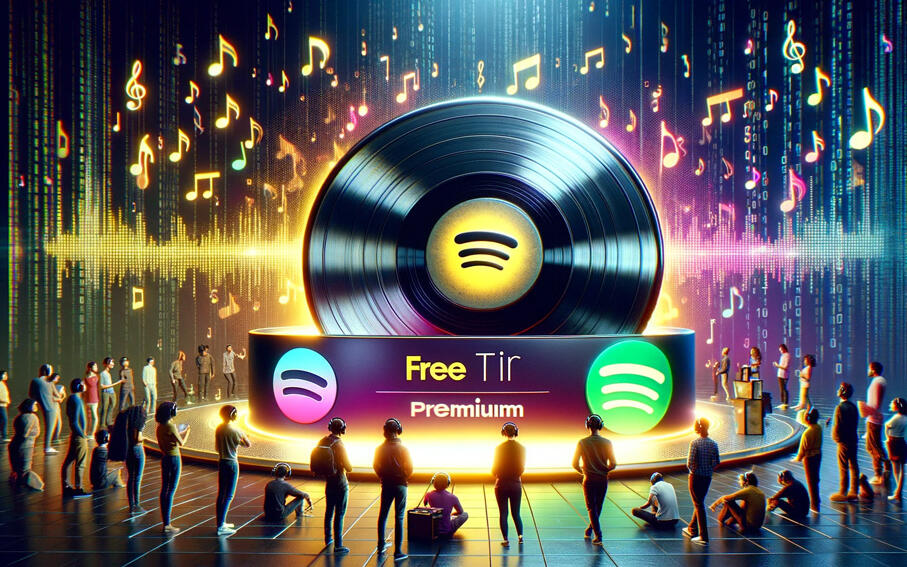Tuning Into Change: Spotify's Crescendo in the Music Industry
Have you ever wondered how a simple idea of streaming music could revolutionise the way we consume tunes today? It's a symphonic blend of technology and melody that has turned the tables on traditional music consumption. Enter Spotify, a maestro in the digital age, orchestrating a service that resonates with millions worldwide. But how did this juggernaut tune into the hearts (and wallets) of listeners on a global scale? The secret lies in the harmonious strings of the freemium model—a strategy that's as intriguing as it is profitable.
The freemium model, a portmanteau of "free" and "premium," has been a game-changer in the tech industry. It’s an approach where basic services are provided free of charge while more advanced features are offered at a premium. In the digital symphony of business models, freemium plays the role of the enticing opening act, hooking audiences with accessible offerings before leading them to the grand crescendo of paid subscriptions.
Now, let's set the stage to delve into Spotify's strategic overture. Our narrative will explore how this streaming virtuoso leveraged the freemium model to not only hit the high notes of user growth but also the crescendo of profitability. From the silent whispers of its free tier to the fortissimo of its premium services, Spotify’s journey is a testament to the power of innovative monetisation in the digital era.
The Rhythm of the Freemium Model
Understanding the Basics of Freemium
In the digital concerto where businesses vie for consumer attention, the freemium model emerges as a melodious strategy that strikes a chord with both start-ups and established tech giants. This business model is akin to a sampler at a confectionery—a few treats offered for free with the hope that the taste will lead customers to purchase the full box. In essence, it's about providing a basic version of a service at no cost, an overture that entices users with the core functionalities while reserving the full suite of features for the premium, paid version.
At the heart of the freemium strategy lies a delicate balance: the free offerings must be enticing enough to draw in users, yet not so comprehensive that they have no need to upgrade. The premium services, on the other hand, should represent a discernible enhancement, justifying the expense with superior functionality, an ad-free experience, or additional content that elevates the user experience from the commonplace to the sublime.
Spotify’s rendition of this model showcases a masterful composition. The platform allows users to stream a vast repertoire of music without reaching for their wallets. This free tier, however, comes with its share of limitations—advertisements punctuate the listening experience, akin to brief intermissions that some may find disrupts the flow of their auditory enjoyment. Moreover, options such as offline listening, unlimited skips, and on-demand playbacks are reserved as encores for premium subscribers.
This strategy is not without its nuances. It relies heavily on the conversion of free users to paid subscribers—a transition that is crucial for sustainability. Spotify's premium offering therefore is crafted to be alluring, providing an uninterrupted stream of music, akin to a private concert where the listener has control over the playlist.
By adopting the freemium business model, Spotify taps into the vast market of casual listeners and converts a portion into loyal patrons. It’s a delicate dance of give and take, where the value proposition must be carefully tuned. As more services adopt subscription-based models, understanding this rhythmic balance between free and premium becomes essential for staying in tune with the evolving market dynamics.
In threading through the intricate melody of the freemium model, businesses like Spotify not only innovate on the product but also the approach to customer engagement and revenue generation. It is a model that has proven its merit, resonating with a diverse audience and charting a course for profitability in the competitive arena of subscription services.
Spotify’s Melody – The Free Tier
Spotify’s Gateway: The Power of Free
Spotify's free tier orchestrates a compelling introduction to its music streaming service, offering a taste of its vast library without a financial commitment. It’s the siren’s song that lures users to Spotify’s shores, providing an accessible entry point for anyone with an ear for music and a desire to explore. This gratis service is not just a feature; it's a strategic move in user acquisition, leveraging the allure of 'free' as a powerful magnet.
Within the Spotify free tier, users discover a myriad of playlists, genres, and artists. The experience is akin to a grand musical buffet, where one can sample different flavours but with certain restrictions that enhance the appeal of the full-course premium meal. For instance, the free version intersperses music streaming with advertisements, reminding the listener that there’s an ad-free session awaiting in the wings, should they choose to upgrade. Furthermore, the free service typically limits song skips and requires an internet connection, subtly encouraging users towards the uninterrupted and flexible experience offered by the premium subscription.
Yet, it's not all about the limitations. The free tier serves as a robust platform for music discovery, allowing users to create and share playlists, thus nurturing a social dimension that amplifies its reach. It’s a clever composition, where the service becomes more valuable as more people use it and share it, creating a network effect that propels the platform's popularity.
The genius of the Spotify free tier is in its dual role as both a standalone service and a teaser for the full premium experience. It's a testament to the efficacy of the freemium model in user acquisition. By giving users an unrestricted pass to explore the world of music, Spotify ensures that its rhythm reaches far and wide, setting the stage for a potential transition to the premium tier. The company has fine-tuned this approach, striking a harmonious balance that not only attracts a vast audience but also sets the tempo for future growth.
In the grand orchestra of music streaming services, Spotify's free tier is the opening act that promises more—more control, more music, and more features. It’s this promise that keeps the user engaged, making Spotify's free tier a fundamental note in the symphony of their business success.
Composing the Premium Experience
Why Upgrade? Spotify’s Premium Perks
Spotify Premium, the crescendo of the platform's offerings, strikes a harmonious chord with those seeking an elevated auditory experience. It's the virtuoso performance to the free tier's rehearsal, providing a suite of benefits that resonate with users looking for a more personalised and seamless encounter with music.
The transition from the free tier to Spotify Premium is akin to moving from the bustling streets to an exclusive lounge. Ad-free listening is perhaps the most melodious perk, allowing the narrative of albums and the rhythm of playlists to flow uninterrupted, free from the jarring interlude of commercials. This unbroken soundscape fosters a deeper immersion in music, where the listener's mood and moment are not compromised by adverts.
Unlimited skips are another maestro's touch, handing the baton of control back to the listener. Premium users can navigate through songs and playlists with agility, skipping tracks that don't match their tempo without limitation. This freedom to curate one's listening experience in the moment is a significant upturn from the free tier's constraints, striking a chord with those who value choice and flexibility.
Furthermore, the ability to download music for offline listening is an encore that many find indispensable. Spotify Premium users can carry their favourite tunes in their pocket, untethered from the need for a constant internet connection. This feature is particularly in tune with the lifestyles of those who are always on the move, making commutes, flights, and remote locations a stage for their private concert.
High-quality audio streaming is yet another benefit that should not be understated. For audiophiles and those with a discerning ear, Spotify Premium offers an enhanced sound quality that ensures every note and nuance is heard in crystal clear definition. It's an auditory polish that elevates the listening experience to concert hall standards.
Spotify Premium also harmonises with various devices, from speakers and smartphones to TVs and cars, providing a symphony of connectivity that ensures your music is accessible wherever you are. This seamless integration with technology enhances the user experience, making Spotify not just a service, but an essential part of the daily routine.
By composing such a robust premium experience, Spotify ensures that its users are not merely passive listeners but active participants in the music streaming narrative. It's an invitation to an exclusive club where the love of music is celebrated without the common interruptions of the digital world. In a market where user experience is king, Spotify's Premium perks are a compelling symphony, beckoning users to take centre stage and conduct their musical journey with finesse.
Charting the Growth
From Free Listens to Financial Success
Spotify's journey from offering complimentary beats to securing a financial crescendo is a narrative rich with strategic crescendos and calculated forte. The symphony of its growth is best understood through a dive into the crescendos of its statistics, the rhythm of its conversion rates, and the melody of its revenue growth.
The platform has witnessed a meteoric rise in users, with its growth statistics striking a high note in the tech industry's charts. At inception, Spotify was but a fledgeling service with a handful of curious listeners. Fast forward, and it boasts millions of active users, a testament to its sticky presence in the daily lives of its audience. The growth trajectory is a clear reflection of a successful business model, where the free tier acts as a powerful acquisition tool, drawing in users with its user-friendly interface and vast music library.
Conversion rates from free to premium are the critical measure of Spotify's success. While exact figures fluctuate with market tides, Spotify has consistently reported a healthy conversion rate, often surpassing industry averages. This metric sings volumes about the perceived value of its premium service. Users are not simply enticed to join for free; they are persuaded to pay for the premium experience. This conversion is the alchemy that transforms casual listeners into committed subscribers, bolstering the company's financial fortitude.
Revenue statistics further illustrate the sonorous success of Spotify's freemium model. The company has seen its revenue streams swell year on year, buoyed by a growing subscriber base and innovative partnerships. Advertising revenue from the free tier also contributes a non-negligible fortissimo to the overall financial picture, despite premium subscriptions being the leading act. These figures are a tangible proof of Spotify's ability to not just attract, but retain and monetise its user base effectively.
In the grand theatre of the digital economy, Spotify has not only secured a seat but has stepped onto the stage to lead the performance. Its ability to translate free listens into financial success is a narrative that many in the tech industry look to emulate. With each quarterly report, Spotify continues to fine-tune its strategy, ensuring that its growth charts remain a series of ascending arpeggios in the grand composition of its market presence.
The Industry Harmony
A Trendsetter in the Music Streaming Chorus
Spotify’s foray into the freemium realm not only orchestrated a personal triumph but set the stage for a transformative era in the music streaming industry. Its model, a delicate balance between free access and premium allure, has reverberated across the sector, prompting a symphony of similar strategies among its contemporaries.
The music streaming industry, once a scattered assembly of disparate services, has found a more harmonious rhythm in the wake of Spotify's approach. Competitor comparison reveals a plethora of platforms now adopting the freemium tune, each with its unique inflection but undeniably influenced by Spotify’s foundational melody. While some offer lossless audio quality to distinguish their premium services, others boast exclusive content or bespoke playlists. However, the underlying structure of the freemium model remains a common thread, uniting them in a collective mission to monetise the digital listening experience.
Spotify’s strategy has not only shaped the offerings of its direct competitors but has also had a broader market impact, redefining user expectations and industry standards. The company's success has underscored the viability and potential profitability of the freemium model, demonstrating that with the right composition of features and marketing, users can be persuaded to transition from free to fee.
In examining the industry landscape, it’s clear that Spotify’s model has struck a chord that resonates throughout the market. The consumer's increasing penchant for on-demand music has been met with an industry-wide chorus of freemium services, all harmonising around the need to provide both accessible and premium experiences. The result is an industry that not only sings in harmony with consumer desires but also dances to the tempo of technological progress, all while keeping a keen eye on the bottom line.
Spotify, maintaining its role as the maestro of this chorus, continues to innovate and adapt. Its impact is seen not just in the numbers on its balance sheets but in the very fabric of the music streaming industry. From orchestrating algorithmic recommendations to curating human-led explorations of music, Spotify’s influence is a pervasive melody, one that continues to shape the sector's evolution.
Facing the Music – Challenges and Criticisms
Discord in the Tune: Addressing the Critiques
The freemium model, while a maestro of market penetration and user acquisition, doesn't hit the right note with everyone. Spotify, despite its crescendo of success, faces dissonance in the form of criticism and challenges that question the sustainability and ethics of its approach.
One of the most resounding critiques lies in artist compensation. The freemium model criticism often highlights that while music streaming services have democratised music access, they have also muddied the waters of fair remuneration. Artists and songwriters have voiced concerns over the pittance they receive from streams, especially from the free tier with its lower revenue generation. This has sparked a debate on whether the model undervalues the very creators it relies on, stirring discussions about the need for a more equitable payout structure.
The conversation around the freemium model's sustainability also plays a prominent refrain. Skeptics question whether the conversion rates from free to premium are sufficient to support not only the platform’s operational costs but also to ensure a profitable future. As user acquisition plateaus in mature markets, the pressure intensifies to convert more free users to paying subscribers, challenging Spotify to continually innovate and offer compelling reasons for users to upgrade.
Moreover, there is a cacophony of concern regarding the market sustainability of the freemium model in an industry that is becoming increasingly competitive. With tech giants and niche players alike tuning their strings to compete, the market is at risk of saturation. The sustainability of Spotify's model is under scrutiny as the industry ponders the long-term viability of offering expansive catalogues of music at no cost.
In addressing these criticisms, Spotify and similar services must engage in a delicate dance. They must not only innovate to remain financially viable but also attune themselves to the voices of artists and users to maintain harmony. The freemium model, for all its accolades, must evolve to quell the discordant notes of dissatisfaction and ensure that the music – and the business – plays on for years to come.
Future Refrains
What’s Next for Spotify and Freemium?
As we gaze into the crystal ball for Spotify and the freemium model, the symphony of the future plays a tune of innovation and adaptability. The future of music streaming seems to be orchestrating a crescendo of change, with industry trends pointing towards more personalised experiences and technological integration.
Spotify, having set the tempo for the freemium approach, is expected to continue its pioneering streak. We might anticipate a bolstering of its algorithmic prowess, further tailoring user experience to individual tastes and listening habits. This would not only enhance the value proposition for subscribers but also serve as a lure to convert free tier users to premium.
Artificial intelligence and machine learning are the conductors of this new era, potentially leading to features that predict and align with user moods, activities, or even social settings. The integration of virtual reality might transform the listening experience from a passive to an immersive encounter, opening up new revenue streams and partnerships for Spotify.
The industry trends also suggest a move towards a more ecosystem-centric approach. Spotify could expand its services to encompass more aspects of entertainment and daily life, such as integrating with fitness, gaming, or educational platforms. Such diversification could solidify its place in a competitive market and justify premium subscriptions.
Furthermore, with the spotlight on sustainability and fair compensation, we may witness Spotify’s strategy evolving to address these critical issues. This could manifest in revised royalty models or partnerships with artists that offer exclusive content and experiences for premium users, ensuring that the creators are remunerated justly while adding value for subscribers.
In the broader scope, the freemium model may undergo refinement to sustain its allure. We could see a more segmented approach, with tiered memberships offering varied levels of access and benefits, catering to a wider spectrum of user willingness to pay.
The crescendo of Spotify’s strategy is thus likely to be a harmonious blend of technological advancement, strategic partnerships, and ethical business practices. As the industry’s composition becomes more complex, Spotify’s ability to adapt its rhythm will be pivotal in maintaining its position at the vanguard of the music streaming symphony.
Harmonising the High Notes of Spotify’s Freemium Success
As we draw the curtain on the intricate performance of Spotify’s freemium model, let’s encore the key compositions that have orchestrated its success. Spotify has deftly tuned into the hearts and playlists of millions, harmonising the delicate balance between free access and premium allure. Their strategy, a symphony of savvy marketing, user-centred design, and technological innovation, has not only amplified their user base but also revenue, setting the stage for a sustainable business model in the ever-evolving music industry.
The free tier stands as the opening act, a no-cost invitation into Spotify’s vast library, easing users into the rhythm of their service. This gateway has been instrumental in user acquisition, laying down the beats for a potential transition to the premium tier. And the premium tier itself? A crescendo of features: ad-free listening, high-quality audio, and unlimited skips, all of which compose a compelling case for users to upgrade.
Yet, the melody isn’t without its dissonance. Criticisms over artist compensation and market sustainability have occasionally interrupted Spotify’s tune, but the company has shown a willingness to adapt and address these concerns. Looking to the future, Spotify seems poised to continue innovating, potentially reshaping not just its own strategy but also the broader music streaming landscape.
Now, as the spotlight fades, we turn to you, the audience. How do you perceive the freemium model’s role in the digital age? Does Spotify’s approach strike a chord with you, or is there a dissonance that can’t be overlooked? Perhaps you’re inspired to see how the freemium model could be orchestrated within your own business symphony.
We invite you to share your thoughts and join the conversation. Comment below with your insights, or if you haven’t yet experienced the Spotify rhythm, why not give it a whirl? Whether you remain in the free tier or decide to compose your days with the premium experience, Spotify’s model is an open stage — and your feedback is the encore we eagerly await.








Comments (0)
Add a Comment